Try Amazon Audible Premium Plus and Get Up to Two Free Audiobooks

Amazon Audible Gift Memberships
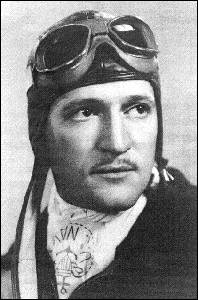 A Flying Tiger's Story by Dick Rossi.
A Flying Tiger's Story by Dick Rossi.
When reminiscing about events that took place fifty and more years ago, it it interesting how one
happening will start a chain of recollections and remembrances long since dormant. The unplanned and
unforeseen circumstances of my early years shaped the entire future of my life and contributed
immensely to the improbable fact of my becoming a Naval Aviator. The direction of the rest of my
life was based on the earning of my Navy wings.
After graduating from St. Ignatius High School in San Francisco in 1933, I put in one semester at
San Mateo Junior College. After one term of hitchhiking from San Francisco to San Mateo each school
day (approximately twenty miles down the bay) then hitchhiking back to downtown San Francisco where
I had a job, then going home to study, I decided it was not practical. My best bet, I figured was to
work full time for awhile and save enough money to have a nest egg for college.
In 1934, in the middle of The Depression, I started pounding the pavement looking for a full time
job. In April I finally landed a job in the Merchant Marines and spent my 19th birthday at sea off
the coast of Central America. It was very difficult to get a job aboard ship in those days but once
you were in the union, it was relatively easy to go from one steamship line to another. For most of
the next five years I was able to travel the world, taking off enough time to complete four
semesters at the University of California at Berkeley.
R.O.T.C. at Berkeley was mandatory for all male freshmen and sophomores in those years. Since I was
taking electrical engineering, I automatically was assigned to the Signal Corps. I used to see the
notices on the R.O.T.C. bulletin board about flight training, but never really dreamed I would be
able make it. I was underweight and our family doctor told me I could never pass the physical.
One of those unforeseen but fortunate circumstances happened in late 1938 as I was sailing on the
S.S. President Garfield on an around-the-world trip (coincidentally, the same ship on which Claire
Chennault sailed to China one year before), I became acquainted with a Navy captain and a Navy
commander on their way back to New York from Manila. I mentioned to them how I would like to go to
Pensacola. When we docked in New York I was pleasantly surprised when each of these officers gave me
a letter of recommendation.
Back in San Francisco in early 1939 I had managed to put on about ten pounds, but I was still
underweight. I submitted my application to the Navy, along with the two letters of recommendation.
Not being very optimistic about my chances, I applied to Pan American Airways for a job as purser on
their Clippers.
August arrived and I had heard nothing, so I went over to Berkeley and signed up for the fall term.
Just before school was to start, I received a notice from the Navy to report to Oakland Reserve Base
for a physical. The mail also brought a notice to report to Pan American on Treasure Island. I set
my priorities. I would try first for Pensacola; if that did not work out, I would go to Pan Am;
failing that I would go back to school.
I reported for my Navy physical and, although still underweight, I was given an N.C.D. (not
considered disqualified). However, I was ordered to report to the dispensary after every meal to
drink an ounce of cod liver oil. I took a lot of ribbing from the other aspiring cadets about that.
Our Elimination Training started in September.
Our class reported to Pensacola the last week of December 1939 and we started our flight training
in January 1940 as class 134-C. After getting my commission and wings, I was ordered to the newly
opened Saufley Field as an instructor at Squadron 1-C. I remained there until August 1941 when, in
the old San Carlos Hotel, I signed up to go to China with Central Aircraft Manufacturing Company in
the American Volunteer Group, which would become known to history as the Flying Tigers.
We were required to resign our commissions due to the covert nature of the job and the relations
with Japan. The contract was for one year with assurance that we could return to the Navy in our old
slot with no loss of seniority. The Pearl Harbor attack would alter the future plans of all the
volunteers in our group.
After checking out of Pensacola, we were all instructed to report to the CAMCO representative at
San Francisco for passage to China. We were told that we would be a fighter group flying P-40s and
that our mission would be to protect the Burma Road; that we would be followed by a bomber group and
then another fighter group. Our group was named the First American Volunteer Group. We did not have
much information and really didn’t know what we were getting into. I have been asked many times why
I volunteered. There are several reasons, here are some: I had been instructing at Pensacola for
over a year and I wanted to get into flying fighters; I felt that it would further my career in the
Navy to go out to China and fly for the one year of the contract; the pay they offered was good; it
seemed like a good thing to do for the US and China; and the adventure of it appealed to me.
In San Francisco the Pensacola contingent of eighteen pilots was joined by more Navy and Army
pilots plus some ground support personnel. Most of the FAVG had already departed which made our
group the last contingent of pilots to arrive in Rangoon. Several additional ground support people
arrived on a later ship.
We sailed from San Francisco on 24 September 1941 on the Dutch ship, M.S. Boschfontein, arriving in
Rangoon on 12 November. That afternoon we boarded the train for Toungoo, Burma, which was to be our
temporary training base. With our arrival, the FAVG was essentially complete except for the half
dozen support people behind us.
We arrived in Toungoo, about 170 miles north of Rangoon, at 2200. Some of the volunteers who had
arrived before us came down from the base to meet us. We all saw some people whom we knew, but had
no idea they had joined the AVG also.
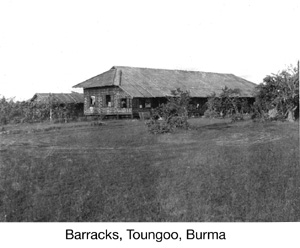
Those who arrived before my group had already been formed into a headquarters section and three
pursuit squadrons. Pursuit was the Army designation at that time for what the Navy called fighter
squadrons. We were immediately assigned to one of these units. I was assigned to the 1st Pursuit
Squadron.
Having been raised in an Italian ancestry family of ten children I thought I was pretty used to
chaos. I later realized that we had been fairly well organized in comparison to some outfits I later
joined. Things in Toungoo did not run too smoothly.
Since our group of pilots on the Boschfontein were the last to arrive, we were way behind the first
arrivals. They had already had months of lectures from Chennault and many hours of indoctrination in
the P-40, plus gunnery, formation and dogfighting practice.
Many things had happened before our arrival including a couple of fatal accidents, resignations,
and various training accidents, resulting in the loss of quite a few of our P-40s. The first few of
our group to get P-40 flight time managed to have a couple more accidents. Chennault was upset about
this and cancelled P-40 checkouts for new arrivals until they had an indoctrination flight in the
group’s BT-9 (or SNJ as we Navy called it). Unfortunately the SNJ was out of commission so our
checkouts were delayed.
More than a week passed before I was able to get a couple of hops in the SNJ and then try my hand
in the P-40. Our P-40 cockpit checkout and instructions came from an ex-Navy pilot, Edgar Goyette.
After almost a year instructing in N3Ns, the P-40 was quite an experience. One of my main
motivations for joining the AVG was to get into combat-type planes. The P-40 definitely fulfilled
that desire. It required full attention to keep it under control.
The RAF squadrons at Mingaladon Airdrome in Rangoon had Brewster Buffalo planes. Many of our Navy
types thought these would perform better than the P-40 Tomahawks. Chennault thought differently and
so arranged for the RAF to send up a pilot in a Buffalo to have a dogfight with one of our P-40s.
RAF Squadron Leader Brandt flew the Buffalo, he was an Ace from the Battle of Britain and we were
quite in awe of him. Erik Shilling flew our Tomahawk and soundly defeated the Buffalo. That was a
morale booster for us.
The Sunday edition of the "Times of India" carried a color photo in its magazine section of an RAF
plane in North Africa with the shark mouth painted on it. It was an instantaneous hit with our whole
group and within days all our planes were adorned with it. It fit the P-40 perfectly.
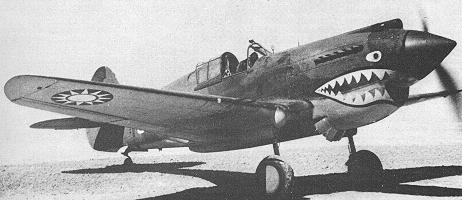
I was able to get about ten hours in the P-40 and was really getting to enjoy it when we were hit
with a slowdown in our flight time. With a few exceptions, all the pilots from the Boschfontein were
put on hold and the flight time was being given to the earlier arrivals. I got a lot of duty and
loafing time for the next ten days. There was a lot of hangar flying and "acey-deucy" games in the
flight line tent. Each of the three squadrons had its own alert tent on the field. There was a lot
of grumbling from those not getting any flying time.
Our whole group was now getting ready to make the move to Kunming, China, which was to be our main
headquarters base. Several truck convoys had started up the Burma Road. Most of our ammunition was
in the convoy which turned out to be unfortunate.
On Monday morning, 8 December, (we were on the other side of the international date line) as we were
showing up at the flight line, first came rumors and then confirmation of the attack on Pearl
Harbor. We were both shocked and excited. We were aware of the danger of a Japanese attack on the
United States, but it was a big surprise that the first U.S. target was Pearl Harbor. Now our
presence had a much bigger purpose. We would be fighting directly for the United States as well as
our allies.
We all seemed to get more serious and intense. There had been Japanese observation planes over our
Toungoo base several times, so we were expecting immediate action. With only part of our planes in
commission, a shortage of ammunition since most of it was in transit over the Burma Road, and planes
being prepared for the trip to China, we were in a vulnerable situation.
Chennault immediately ordered a couple of planes to fly patrol over the field. The other planes
ready to go were warmed up periodically so that takeoff would not be delayed.
That night we instigated a blackout which was kept up for the duration of our stay. News was very
limited and all we heard about were allied disasters. The Japanese taking of Thailand meant we were
only one hundred miles from enemy fields. Pearl Harbor had now made our move into China from Toungoo
uncertain. We were hoping for some good news to come out. We certainly didn’t know that we would be
the ones supplying it.
We were issued gas masks and steel helmets and everyone wore their sidearms. At night, six pilots
were on alert. Barbed wire was going up everywhere, slit trenches were dug in case of a bombing, the
place was a beehive of activity.
There was an alert about 0300 on 10 December and the six night standby planes took off. It was a
false alarm and unfortunately, one of our planes crashed on landing in the dark, but the pilot got
out okay.
The same day we received the news of Pearl Harbor I started to get more P-40 time. I soon
discovered that dogfighting, while very exciting, was a lot of physical work. I was enjoying it, but
after only getting eleven hours of flight time, we were back on the bench with lots of day and night
guard duty.
With most of our baggage already on the way to Kunming, low on ammunition, and planes sitting around
waiting for props and wheels, we were pretty frustrated. Chennault conferred with the British and
Chinese and it was decided to send the 3rd Squadron to Mingaladon Airdrome at Rangoon on 12
December, and that the 1st and 2nd Squadrons would move up to Kunming as soon as possible. The 3rd
Squadron would operate with the RAF.
More of our truck convoys were sent up the Burma Road and on 18 December, the flyable planes of the
1st and 2nd Squadrons left for Kunming with a couple of take-off accidents taking place. More pilots
than planes were available, so some of us joined Chennault in a Chinese National Aviation
Corporation DC-3 for the trip to China, with a stopover in Lashio, Burma. We arrived in Kunming in
the evening to find out that it had been bombed that day.
Quarters and food in Kunming were a big improvement over Toungoo. A good supply of flight gear was
available, including the Navy leather jacket. I had brought mine from Pensacola, so did not take a
new one.
The headquarters staff and the 2nd and 3rd Squadrons were housed in a converted university at the
far side of town. The 1st Squadron was placed in new adobe-type barracks close to the entrance to
the airport.
On 19 December 1941, I had my first P-40 flight time in a week and it felt good to get in the air.
Because of the surplus of pilots, the 20th was my day off, but it turned out to be our first combat
with the JAAF, which I had to watch from the relative safety of the local graveyard.
The JAAF had been making bombing runs on Kunming without opposition so they didn’t bother with a
fighter escort. This time we had a surprise in store for them. Newkirk, leading the 2nd Squadron,
made a pass at the bombers as they turned to head for their homebase at Hanoi. He returned and
reported that when the bombers spotted them they had run away. However, the 1st Squadron which had
the top cover assignment dove on the bomber formation and in a running fight, brought down four of
them and reported damage to most of the others. Several of our planes were shot up, but all the
pilots returned uninjured. We were a jubilant bunch, and the Japanese did not return to Kunming
again during our stay in China.
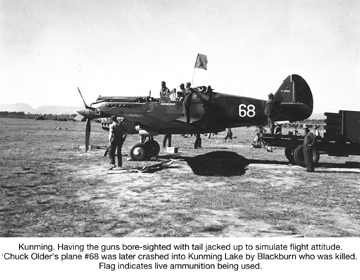
We now had a gunnery range and one day I got in a couple of practice hops. With all six guns
firing, the P-40 is a pretty potent weapon. It was a real confidence-builder.
On 23 December, the citizens of Kunming came out and thanked us for the action of the 20th and for
saving Kunming from another bombing. They brought flowers, fruit and decorations.
Our Christmas Eve spirit was depressed by the news of the loss of three or four of our pilots. With
the communications we had, the reports were pretty vague. The 3rd Squadron had been engaged in a
massive attack by the Japanese against Rangoon, and a flight of three CW-21s from Toungoo bound for
Kunming got lost, ran out of gas and crashed short of Kunming. Later reports verified that we had
lost two pilots in Rangoon and one was killed in a crash about fifty miles west of Kunming. The good
news was that we had great success in shooting down many of the Japanese planes.
On Christmas Day the Japanese returned to Rangoon with an even larger armada of bombers and fighter
escorts. Again, the AVG and RAF went up to meet them with even greater success. This time the AVG
lost no pilots and managed to bag nineteen enemy aircraft.
There were a few false alarms prior to Christmas in Kunming, but all was quiet on Christmas Day. We
were then issued our much-publicized "blood chits." These were the silk scarfs that had the message
in Chinese stating that we were an American flier and they should help us in returning to our
outfits. Some members of the group had them sewn on their flight jackets or flying suits. Others,
including myself, just folded them up to carry in our shirt pockets. The reason to keep them in this
manner was to be able to have them with us regardless of what we were wearing.
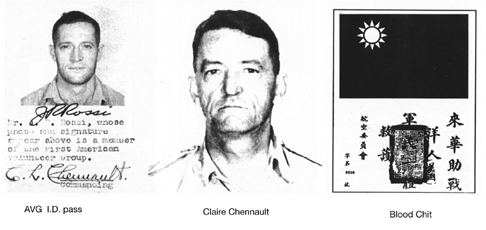
The 2nd Squadron in Rangoon asked Chennault for additional help and the "Old Man" decided to send
eight planes and pilots from the 1st Squadron to reinforce the 2nd Squadron. The 2nd had replaced
the 3rd in Rangoon in the week between Christmas and New Year’s Day.
Bob Neale was to lead the 1st Squadron detachment and I was lucky enough to be one of those
selected to go. We were set to leave Kunming on 12 January 1942. The plan was to fly to Toungoo to
refuel and spend the night. Then we would leave Toungoo early with enough fuel to handle an alert
condition on our arrival at Rangoon if it was necessary.
Bob Little’s plane needed some maintenance so our takeoff was delayed a couple of hours. Our flight
consisted of Bob Neale, "Pappy" Boyington, "Black Mac" McGarry, Bob Little, Jack Croft, Bill
Bartling, Frank Schiel and myself. Quite a few of us had requested the duty.
Upon takeoff my engine began to backfire and it cut out just as I was getting gear up. I
immediately put the gear control in the "down" position and made a 270° turn and landed across the
field. We didn’t have an actual runway at that time as it was under construction, we just had a
large grassy field.
The loud noise of my engine had alerted the ground crew causing a crew chief to immediately jump
into another plane and start it up. By the time I could roll to a stop, they were taking my baggage
to the other plane. I crawled out of the cockpit, grabbed my parachute and ran over to the other
plane. By this time, the other seven planes were out of sight. Bob Neale had the only map; however
we had been given a mimeographed sheet that showed a couple of rivers, a tall mountain and some
magnetic headings.
As I was securing my parachute, our squadron leader, Sandell, jumped up on my wing and said I could
either take off and try to catch up or cancel the trip. I was not about to miss out on this chance
to get into action. He reminded me that I had better not get into any trouble as it would be his
"butt" if anything happened to me or the plane. I did not see the logic of this and his "butt" was
not my primary concern.
I had gone to Kunming from Toungoo in CNAC’s DC-3, so I had not seen much of the terrain. The "map"
proved useless. There were really four good-sized rivers before our point to turn in a southerly
direction. After I crossed the first two rivers my dead reckoning told me it was time to take the
turn south, but the high mountain checkpoint was not in sight. In 1941 nobody knew anything about
the jet streams, and I must have been bucking about a seventy-knot wind.
I flew on for another thirty-five or forty minutes getting more and apprehensive.
Still no tall mountain, railroad tracks only extremely rough terrain below.
It felt pretty lonely up there. I was hesitant to turn our planned southerly heading, not having seen any of the anticipated checkpoints.
With a dwindling gas supply, hoping at least smooth area try gear landing if necessary.
I decided to refigure all my dead reckoning and try to at least get some general idea of where I
should be. I was in the process of making a 360° turn and as I put my left wing down I saw an
airfield right below me. I immediately throttled back and started a descent for a landing. On final
approach, with gear and flaps down, I suddenly thought that this might be a Japanese field, but with
only fifteen minutes of fuel left, there were not many options.
There was a small shack about midway down the field and as I rolled to a stop and began taxiing
back, I had an eerie feeling. There was no one in sight. Then I noticed some movement in a machine
gun nest off to one side.
Not knowing what to expect, I rolled up to the shack and cut the engine. It was a huge relief to
see a young British officer step out of the door of that shack. He was an engineer and had overseen
the construction of the field. He told me that he thought I was a Japanese photoship, hence his
machine guns were manned and ready. He said it was a relief to see the American insignia on the
plane, although it was actually the Chinese insignia.
Fortunately, he had a supply of one hundred octane gasoline. It had to be filtered through a
chamois to clean it and he gave me enough to get to Toungoo which was only 165 miles southwest.
While my plane was being fueled he showed me our location. He had a fine map of Burma on his wall.
While I studied it, he had tea served along with a shot of Red Label Scotch. He was the only Anglo
at the station, which was called Nam Sang.
With the fueling and social visit complete, I took off for the flight over the hills to Toungoo. As
I parked the plane at Kyedaw, our first base, the first question I got was, "Where are the other six
planes?" When I replied that there should be seven more, I was told that one had already been
reported lost.
Continued in Part Two.

All text and images copyright © J.R. Rossi 1995.
Reproduction for distribution, or posting to a public forum without express
written permission is a violation of applicable copyright law.







